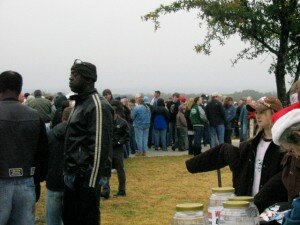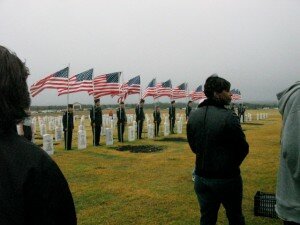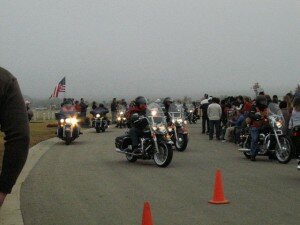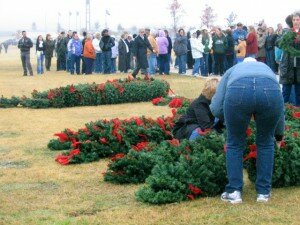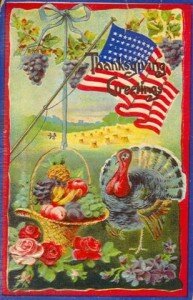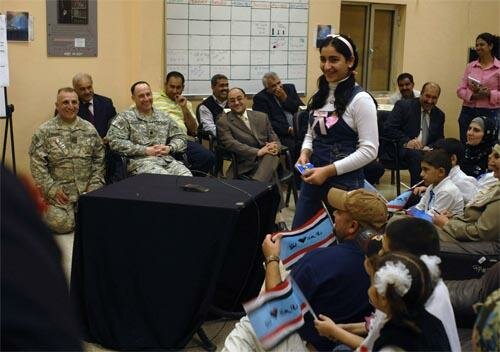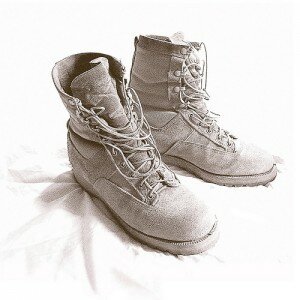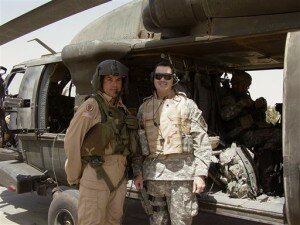Honoring Fallen Warriors For The Holidays
November 29, 2008
The morning air was crisp and cool, overcast with a few drizzles, as hundreds of citizen volunteers from the Central Texas area, gathered together at the Central Texas State Veterans Cemetery to complete a very special mission. They gathered this morning, to honor our fallen military warriors, as the Christmas season begins and Marty and I were proud to be part of this wonderful group of people gathered there this morning. People had came from as far away as Wichita, Kansas to take part in this event.
Today was the day, that the Friends of The Central Texas Veterans Cemetery set aside to decorate each grave with a wreath. The ceremony was to begin at 10am with local ROTC students presenting the colors, the singing of America The Beautiful, and a short invocation. Shortly before the event began, the silence was broken by the sound of hundreds of motorcycles, as members of the Patriot Guard Riders and local motorcycle clubs arrived to take part in the event. Seeing all the motorcycles arrive together was a sight to behold and one that many of us hold dear to our heart, because of the mission they have taken upon themselves.
After the prayer, the first to lay wreaths, were the Gold Star families, who were allowed a few moments alone with their fallen warrior, as they laid the wreath on his or her grave. Afterwards, the remainder of the crowd was to take a wreath each and place it upon one of the graves that remained undecorated.
I wasn’t sure what to expect as we headed towards the cemetery this morning. Unsure, if the cooler weather would cause people to stay at home where it was warm. I was pleasantly surprised and proud of the number of people who braved the cool weather to take part in this event. People from all walks of life were there, many with their small children. Civilians, Soldiers and Veterans all joined together to complete this very special task. While this event, was not part of the nationwide Wreaths Across America, it was inspired by that. When the Central Texas State Veterans Cemetery was completed in 2006, they received 6 wreaths from Wreaths Across America, one in honor of each branch of the military and MIA/POWs. At the time, there were not enough wreaths to ensure each grave had one, until one lady decided that each veteran in the cemetery deserved to be honored with a wreath on their grave, and within 3 days, she had gathered enough wreaths to decorate each of the 900 graves that were then at the cemetery. This year, there are more than 1400 graves and each one of them had a wreath placed on it and each veteran interred in the vaults also had a wreath placed in their honor.
I was very touched and inspired by the huge crowd that turned out this morning. This is something that Marty and I plan to take part in every year. I encourage each of our readers, who live near a Veterans Cemetery, to take part in such an event, or perhaps organize one yourself. I think you’ll be as inspired as we were this morning.
Celebrating The Things We’re Thankful For
November 27, 2008
Every year, we here in the United States, gather together with our loved ones to celebrate Thanksgiving Day, a day that is dedicated to celebrating all of the things that we’re thankful for. As we go about our busy lives each day, we often don’t give much thought about just how lucky we are to live in the greatest country on the planet. We rarely think about the history of our country and how the United States came to stand for freedom, liberty, privilege, and yes, at times even excess.
Today is a day to reflect on all of the things that we’re thankful for in our lives … and yes we have many things to be thankful for. We live in a society in which we are able to make choices, instead of having someone make those choices for us. We have the freedom to chose where we live. We have the freedom to chose what profession we wish to pursue. We have to freedom to obtain an education in order to help us in our profession. We have the freedom to chose our partners, where our children attend school. We have the freedom in our country to decide for ourselves what religious path we wish to follow or not follow. We have the freedom to speak out against things we don’t feel are right and to have a voice in how our government is run. Unfortunately, many times, with these freedoms, comes the habit of taking these things for granted, when they are gifts that have been given to us. Gifts that have been paid for, with the blood, sweat and tears of generations of brave men and women who were willing to pay the price for us, as American citizens, to have these freedoms, even if that meant giving up their own right to these freedoms. For that wonderful, blessed gift, we should be eternally Thankful.
I hope that as each of us gathers to celebrate this special time with their family and friends, that they’ll think about the thousands of men and women, our American Soldiers, who are spending this day, far away from their loved ones, to ensure that we’re able to spend our Thanksgiving Day with our loved ones. Please take a moment to say a prayer of thanks for these brave warriors and ask for their protection, to whatever God you chose to worship. As you count your blessing and say thanks for them, don’t forget that these brave souls and those who came before them, are the very reason that we’re able to have such celebrations in our country. As I gather with my loved ones today, and we set down to a delicious Thanksgiving feast, there will be a special place of honor at our table. A place set that no one will be sitting at, but one that is in honor of every man and woman currently serving in our country’s Armed Forces, who can’t be with their loved ones today. I am so very lucky and so very Thankful for our Troops, not only today, but every day. I hope that you are as well.
To each of our readers, I wish you a very blessed and safe Thanksgiving Holiday. To our Troops and our Veterans, I an so very thankful for you and everything you have made possible in my life and the lives of our fellow Americans. Stay safe and know that you’re always in my thoughts and prayers.
Iraqi & American Children Make New Friends
November 25, 2008
Many of the children, who live and attend school in the communities surrounding Fort Hood, have parents who serve in the military. Many of them have seen their mothers or fathers or both head to war in Iraq or Afghanistan. Often they’ve heard their parents speak about the children they encounter in those countries and many of them are curious about the different culture that these children live in. Students at Nolanville Elementary School in Nolanville, Texas, grades 4 and 5 were able to learn more about their Iraqi counterparts on November 12 and in the process, were able to make new friends. All thanks to a video teleconference between the Iraqi and American school children. The program that day, began with opening remarks from Maj. General Jeffery Hammond, commanding general of the 4th Infantry Division and Multi-National Division-Baghdad.
“The school partnership program continues to build and grow in all directions,” said Hammond.1
Right now, there are approximately 31 Iraqi and American schools who are participating in the program. The schools here in the United States are in 11 different states. As part of the program, the students are able to exchange letters and emails with each other, as well as participate in video teleconferences. This enables students in Iraq and the US to learn about different cultures and develop more awareness of the differences as well as the similarities. The Iraqi students participating in the November 12th VTC were from the al Khartoum Primary School in the Shurta community of southern Baghdad. They gathered at FOB Falcon to participate in the VTC which allowed them to participate in a question and answer session with their American peers in Nolanville.
“My experience is that the young school-aged children in Iraq are no different than the children in America,” said Hammond, who explained that the program is designed to foster communications between Iraqi and American youths and develop a better understanding of the different cultures.2
Children from both countries were able to ask questions and make remarks about a vast number of subjects, such as school, life and culture in their respective countries. The children found that even though they were thousands of miles apart, that there were many similarities. Both children in America and Iraq have homework and chores. Both like hanging out with their friends and they both like chocolate ice cream.
“They’re not much different than us. They just dress a little different,” Essie Hubert, age 10 said. “They don’t care about the war. They still like us.”3
While the war in Iraq, touches both sets of children, it does so in very different ways. For the children in Nolanville, the war touches them because of parents, family members or friends being deployed. For the Iraqi children, they live in a combat zone and are impacted in a much different way.
“Do you hear sounds of gunfire all the time like we do, where you live?” one Iraqi boy asked the American students.4
The children were surprised to learn just how much they really knew about each other’s culture, as the VTC progressed. They found that they had many things in common and that despite the war, their daily lives were very similar as well.
“I was very pleased to talk to the American students, and I was well educated on how their educational system works,” said Aseel Mazin, a 12 year old girl. “I got to learn what their daily schedule is like too.”5
One difference that the American students learned, is that their Iraqi counterparts attended school from Sunday through Thursday for half days, while they of course, attend school for full days Monday through Friday. I’m sure that will get several of them asking their teachers if they can switch to half days of school. One American student asked their Iraqi counterpart about the Arabic language. After that question, an Iraqi student asked why American children do not learn the Arabic language in their school.
“It’s not really in our curriculum,” said Jordan Reed, daughter of Maj. T.J. Reed, Civil Affairs officer assigned to HHD 1st BCT, 4th ID. Her response brought laughter from those in attendance.6
These children are the future of Iraq and the United States. By participating in such events, I would hope that these children can bridge the gap of cultural difference that often cause older generations to embrace hate against the unknown. Our hope and the hope of Iraq, like in the hands of children like these. My hope is that this type of cultural exchange will foster long lasting friendships, which can someday change the world and make it a better place for future generations.
- http://www.forthoodsentinel.com/articles/2008/11/20/news/living/living04.txt [↩]
- http://www.forthoodsentinel.com/articles/2008/11/20/news/living/living04.txt [↩]
- http://www.forthoodsentinel.com/articles/2008/11/20/news/living/living04.txt [↩]
- http://www.forthoodsentinel.com/articles/2008/11/20/news/living/living04.txt [↩]
- http://www.forthoodsentinel.com/articles/2008/11/20/news/living/living04.txt [↩]
- http://www.forthoodsentinel.com/articles/2008/11/20/news/living/living04.txt [↩]
Wounded Heros Reunite After 18 Long Years
November 22, 2008
So many times, for various reasons, when parents divorce, family connections are broken between children and parents. Imagine that as a child, your mother and father split up. You live with one parent and never have the opportunity to see your other parent again. Imagine how that would leave an empty spot in your life that could never be filled. In this instance, for the past 18 years, SPC Carlos Herrera has thought about and wondered about his father; where he was and what he was doing. His parents had divorced when he was young and over the years he had lost touch with his father, Emanuel “Manny” Herrera. I introduced our readers to SSG. Emanual “Manny” Herrera, when I shared his story back in June of this year. I had met Manny in San Antonio and felt that he had a very compelling story that our readers would like to know about.
On Tuesday, SPC Herrera finally to realize his dream of finding his father and making up for lost time, when they exchanged their Purple Hearts in a very rare and very personal ceremony. The ceremony was their way of reconnecting and preserving that special bond between fathers and son. A bond that they swear will never be broken again. It was a start for them to be able to make up for all the special times over the past 18 years that they have missed.
“There are powerful emotions,” said SSG Herrera. “I never stopped looking for him.”1
Also on Tuesday, Spc Herrera learned that he would be deploying for Iraq for the third time, next month. Though they only had a weekend to share with each other, Carlos and his father made up for lost time, spending as much time as possible together. Often late into the night, talking about things and sharing family photographs. It was a poignant reunion and a very special weekend for both Carlos and Manny.
When Manny and Carlos’s mother split up, they were living in El Paso. Carlos was only 5 years old and as most children of that age, probably didn’t understand what was happening. After their divorce, Carlos and his mother moved to the Dallas area. Manny moved to Phoenix. Both parents went on with their lives and Manny and Carlos lost touch with each other. Despite losing contact with each other and living so far away from each other, that didn’t diminish the love that they had for each other. There was a special piece missing in each of their lives.
“I would always look in the telephone book, trying to find him,” Carlos said. “My mother felt that I had a lot of anger built up, not getting to know him.”2
Unbeknownst to both of them, almost twenty years after losing touch with each other, they were both serving in Iraq, north of Baghdad. They were literally a few short miles away from each other and neither of them knew. Manny spoke of making convoys to the FOB where Carlos was serving. Even though they were so close to each other, their paths never crossed.
On November 21, 2006, SSG Herrera was wounded when a bomb detonated, causing herniated discs in his back and neck, partial hearing loss and traumatic brain injury. Currently he is still undergoing treatment for his injuries at Brooke Army Medical Center in San Antonio. Almost three months later, Carlos was injured in a mine blast on February 12th 2007, ironically enough, only 15 miles from the site of his father’s injury. Carlos suffered shrapnel wounds to his arms and legs, as well as temporary vision loss.
Manny shared how he had been told by someone that they had searched the internet to find an article about him. That gave him the idea, that he should do an internet search as well, to see if he could locate his ex-wife and his son. Three weeks ago, after 18 years of searching and hoping to somehow reconnect, Carlos and his father were reunited over the telephone. At the time, Carlos was at Fort Bragg, recovering from his injuries. Manny of course, was concerned about his sons injuries and asked where he was and how badly he was injured. At times, they struggled to find the right words to say to each other.
“There was so much I wanted to say, but I was speechless,” Carlos said.3
Because of the help of several wonderful groups of people, their reunion was made possible. They received assistance from the Warrior and Family Support Center at Fort Sam Houston, as well as the Fisher House Foundation’s Hero Miles Program. They agreed to exchange Purple Hearts with each other, after checking to make sure that doing so, wouldn’t violate any military protocol. When they met, Manny was delighted to meet his daughter-in-law Desiree and his two young grandsons. Desiree was thrilled to see her husbands dream finally come true, after so many years.
“It’s what he’s always wanted,” she said, as she cradled their infant son.4
Following his next tour in Iraq, Carlos and his father plan to spend a lot of time together, making up for lost time. They plan to hunt, fish and ride motorcycles together. Eventually, his father wishes to remain on active duty and return back to the Phoenix area. Despite the miles that will separate them, they vow that never again will they lose touch with each other.
“There’s no chance of us breaking that string of contact ever again,” said Manny.5
I was so happy for Manny when I received an email from our mutual friend, Bob Kunkle. Manny is such a wonderful person and I know this reunion with his son meant the world to him. Hopefully, now that they’ve been able to reunite, they’ll have many more happy years to reconnect and share their lives. It’s wonderful that both of these Heros have finally been able to have their dream come true.
To view a video of this very special reunion by following this link.
- http://www.mysanantonio.com/news/local_news/Purple_Heart_medals_reunite_wounded_father_son.html [↩]
- http://www.mysanantonio.com/news/local_news/Purple_Heart_medals_reunite_wounded_father_son.html [↩]
- http://www.mysanantonio.com/news/local_news/Purple_Heart_medals_reunite_wounded_father_son.html [↩]
- http://www.mysanantonio.com/news/local_news/Purple_Heart_medals_reunite_wounded_father_son.html [↩]
- http://www.mysanantonio.com/news/local_news/Purple_Heart_medals_reunite_wounded_father_son.html [↩]
In Their Boots
November 21, 2008
Here at A Soldier’s Mind, we’ve tried to make sure our readers were able to read the stories of our Troops. Be it the stories of heroic actions that our Troops have taken in the combat zone, to struggles they’ve faced when they’ve returned home from combat. We’ve attempted to keep our Troops abreast of the many accomplishments our Troops have made in the places they’re deployed, as well as the many things they’ve accomplished here at home. The media, unfortunately has made our Troops out to be robotic-like individuals, who do nothing but follow what they often term “illegal orders” and have no mind of their own. Because of that, we’ve tried very hard to tell our Troops stories, to show the people who chose to wear our country’s uniform in a much more accurate light than they’re usually portrayed in the media.
Yesterday, I stumbled across a website of documentaries that are streamed online, that portray our Troops, in their own words. These documentary clips are in their own words, told by the servicemember who is being portrayed. Their stories are very real. Stories that everyone in our country should make it a point to hear. The stories being told aren’t always pretty, but I promise you, they’re very real. The stories will make you really think about some of the issues that our Troops face, when they go to combat and then return home. How the experiences they face in combat, can change how they interact with the world, with their family and friends. You’ll also hear the stories from family members who’ve had to cope with some of the challenges that come with war.
Will these stories, these true stories change the way you look at our Troops? Will these stories change the way you feel about our Troops being sent into combat in Afghanistan and Iraq? Will these stories change the way you interact with our Troops? Those are questions I can’t answer, but I can tell you that these stories should provide you with a much better understanding of the issues that face these brave warriors, their families and their friends.
When I first heard about this website, I was a bit hesitant, because of the background of the group that is behind the project. However, I decided that it was worth checking into and I was quite impressed. The stories told aren’t done in a judgmental way. They’re apolitical in nature, which was a condition of the grant that the Brave New Foundation received from the financial backer of this project, the Iraq Afghanistan Deployment Impact Fund.1
I urge you, to take the time to visit the In Their Boots website and view the documentaries that are there. The films are relatively short, lasting around 20 minutes, but compelling and a look at our returning Troops that is rarely seen in most projects that have been in the media thus far. I really think you’ll walk away with a much better understanding and appreciation for our Troops and what they deal with, both downrange and when they return home.
- http://www.armytimes.com/news/2008/11/ap_documentary_111908/ [↩]
“One-Stop Shop” For Wounded Warriors & Their Families
November 20, 2008
When the problems at Walter Reed came to light, President Bush created a committee to investigate where the government was failing their wounded warriors and to come up with suggestions for solutions to fix the problems that were discovered. That committee, headed by former Kansas senator Bob Dole and Donna Shalala, had many suggestions, which have been being implemented across the military and in the VA over the past year. One of the problems identified, was the sometimes seemingly endless agencies and programs that the Soldier and their family had to navigate, often without much guidance. Thus the idea was formed to create a kind of a “one-stop shop” in which warriors and their family members could access these services in one location.
I was fortunate enough to be able to participate in a Bloggers Round Table teleconference on November 12th about the US Army Soldier and Family Assistance Centers (SFAC), of which there are currently 34 at Army installations across the Army. The presentors for the event were Major General John Mac Donald, Commanding General of Family, Morale, Welfare and Recreation Command and Mrs. Delores F. Johnson, director of Family Programs, Headquarters, US Family, Morale, Welfare and Recreation Command. The SFACs are designed to be kind of a “one-stop shop” for wounded warriors and their families, to make obtaining information and care much easier and less time consuming. Services and programs are located under one room, in a single facility to make access to these services much more efficient for wounded warriors and their family members.
The environment at the SFACs are warm and friendly, making the facility inviting to the Soldiers and their family members, which in turn can promote physical, spirtual and emotional healing. Many services are located under the roof of an SFAC and staff is available to help the Soldiers and their family members navigate the sometimes confusing system and access the programs and services that are right for them.
Services that are provided at SFACs are:
* Military personnel and in/out processing
* Benefits counseling: Federal (VA, Department of Labor, Social Security, Medicare) and State
benefits
* Finance (military pay, travel pay and per diem)
* Emergency financial assistance, Army Emergency Relief & money management solutions
* Identification cards
* Receiving and disburtion of donations to soldiers
* Internet access
* Family assistance & support programs
* Traumatic Serviceman’s Group Life Insurance
* Army Wounded Warrior Program
* Child & Youth Services (including child care)
* Installation access
* Retirement services
* Veterans benefits counseling
* Conduit to federal, state and non-governmental organization services
* Education counseling
* Transition/employment assistance
* Referral servicesSome SFACs may offer additional services based on local needs.
Programs at the SFAC are available to the Wounded Warrior, their parents, spouses, significant others and other family members who may not have knowledge about the military. The hopes are that with the “one-stop shop” type availability it will decrease stress on the Soldiers and their family members. In the Army, there is a lot of excitement about the SFACs and the response from the Soldiers and family members alike has been extremely positive.
Along with the services available at the SFACs are activities that are planned for the Troops to participate in, such as the Warrior Adventure Quest. One of the presenters, Major General John Mac Donald shared that this is a “new flavor of an old program.” Warrior Adventure Quest is combination approach of activity along with phychologists who work with the battle-mind programs. The program focuses on high adrenalin events and by using the Battle-mind techniques, helps to “talk them down” and help them to explore the thoughts and feelings that lead to them seeking out high adrenalin activities. Often when a Soldier leaves the combat zone, where they’ve been exposed to high levels of adrenalin due to the nature of the things they face in combat, coming home doesn’t provide the same levels of adrenalin that combat does. Because of that, the Soldier may seek out high risk activities, in order to reach that same level of adrenalin they had in the combat zone. This can lead to accidents, difficulties at home and problems adjusting to the slower paced life at home. In the Warrior Adventure Quest activities, the Soldiers are able to experience the “high adrenalin” activities in a controlled, thus safer environment.
I’m excited about what the SFACs can do to promote and assist in the healing of our Wounded Warriors, whether they’re planning to stay in the Army following their recovery, or transition into the civilian world. I think family members and Soldiers alike will find virtually everything they’ll need during the recovery and transition period. I’m excited to see what new programs and changes will be added as time progresses and this is something I’ll attempt to keep our readers abreast of. If you know a wounded warrior or family member, please don’t hesitate to refer them to their local SFAC. The following installations currently have SFACs.
Balboa Naval Hospital in California
Fort Belvoir, Va.
Fort Benning, Ga.
Fort Bliss, Tx.
Fort Bragg, NC
Fort Campbell, Ky.
Fort Carson, Co.
Fort Dix, NJ
Fort Drum, NY
Fort Eustis, Va.
Fort Gordon, Ga.
Fort Hood, Tx.
Fort Huachuca, Az.
Fort Irwin, Ca.
Fort Jackson, SC
Fort Knox, Ky.
Fort Leavenworth, Ks.
Fort Lee, Va.
Fort Leonard Wood, Mo.
Fort Lewis, Wa.
Fort Meade, Md.
Fort Polk, La.
Fort Richardson, Ak.
Fort Riley, Ks.
Fort Sam Houston, Tx.
Fort Sill, Ok.
Fort Stewart, Ga.
Schofield Barracks, Hi.
Fort Wainwright, Ak.
USAG Grafenwoehr, Germany
USAG Heidelberg, Germany
USAG Kaiserslautern, Germany
Walter Reed Army Medical Center
West Point, NY
To access the SFACs if you’re not near one of the above locations, or if you just have questions, you can call the Warrior and Family Hotline: 1-800-984-8523 24/7. Those overseas may call DSN: 312-328-0002. Stateside the DSN number is: 328-0002. You may also reach the SFAC information by emailing .
Army One Source also provides information on accessing the SFACs.
General Defies Military Culture Of Silence About Mental Health Issues
November 18, 2008
As those who’ve been to war before them, our Troops who are fighting in the wars in Afghanistan and Iraq, sometimes come home with Post Traumatic Stress Disorder. The military culture has long been that to admit that they were having trouble dealing with the traumatic things they had to do or that they saw on the battle field, was a sign of weakness. In the past, those who spoke up about problems they were having were told to “Suck it up and Soldier on.” The military is working hard to erase that stigma and one General is defying that culture of silence and sought help to deal with his PTSD.
Army Major General David Blackledge was a commander of a civil affairs unit on two different tours in Iraq and now works in the Pentagon as Army assistant deputy chief of staff for mobilization and reserve issues. In February 2004, while on a mission during his first deployment, his convoy was ambushed. Since that time, he has suffered from flashbacks and nightmares. His interpreter was shot through the head, the vehicle he was in rolled over numerous times and when he crawled out of the wreckage, he was suffering from a crushed vertebrae and broken ribs. As he crawled from the vehicle, he found himself in the middle of a firefight. Blackledge and the other survivors took cover in a nearby ditch.1
“It’s part of our profession … nobody wants to admit that they’ve got a weakness in this area,” Blackledge said of mental health problems among troops returning from America’s two wars.
“I have dealt with it. I’m dealing with it now,” said Blackledge, who came home with post-traumatic stress. “We need to be able to talk about it.”2
The stigma of silence about mental health problems is something that has military officials worried. Today’s leaders don’t wish to see mistakes of the past repeated with today’s warriors and are encouraging leaders to act as examples for the Troops they lead. It is estimated that as many as 1/5 of the more than 1.7 million Troops who have served in wars, have symptoms of PTSD. Leaders know they have a tough road ahead in changing the stigma, as about half of those with symptoms have not or are not seeking help. Many feel that it will harm their chance for promotion, if they seek help. Others feel that they’ll be thought of as weak and ostracized by their peers, if they admit they need help.
“Stigma is a challenge,” Army Secretary Pete Geren said Friday at a Pentagon news conference on troop health care. “It’s a challenge in society in general. It’s certainly a challenge in the culture of the Army, where we have a premium on strength, physically, mentally, emotionally.”3
Admiral Mike Mullen, the chairman of the Joint Chiefs of Staff has asked senior leaders to help by setting an example for their Soldiers, Sailors, Airmen and Marines. According to Mullen, the culture can’t be challenged and changed, if senior leaders won’t seek help when they need it. While much work is still needed to eradicate that stigma, slowly, it is changing. But there’s much more work to be done.
Brig. General Loree Sutton, the Army psychologist who heads the defense center for psychological health and traumatic brain injury, is currently at work to develop a campaign where those suffering from PTSD, the families and others, are able to tell their personal stories. They will be able to also share their concerns and ideas through web links and other programs. General Blackledge volunteered to help. Last week, he and his wife Iwona, an Air Force nurse, spoke on the subject at a medical conference.4
After he was injured in Iraq, Blackledge was flown to Walter Reed Army Medical Center for treatment. He was visited by a psychiatrist shortly after his arrival. Throughout his 11 month recovery, Blackledge had several sessions with the doctor.
“He really helped me,” Blackledge said. That is the message that he conveys to the Troops. “I tell them that I’ve learned to deal with it,” he said. “It’s become part of who I am.”5
Occasionally, Blackledge admits, he still has dreams about what happened about once a week or so. But he no longer awakes in a cold sweat and they no longer unsettle him as much. On his second tour in Iraq, Blackledge traveled to Jordan to work with local officials on issues concerning the Iraq border. He was in a hotel in Amman in November 2005, when suicide bombers attacked. That attack killed around 60 people and injured hundreds more. He received a whiplash injury that took several months to heal. That trauma, rekindled his PTSD symptoms. This time however, they weren’t as strong as they were after the 2004 event.6
General Blackledge is a prime example of Military leaders taking steps to erase the stigma against seeking mental health care and he’s leading by example, seeking help for his own problems. Over the past year the military has made it much easier for Troops suffering from PTSD to get the help they need. One way they’ve done that is by embedding mental health teams into military units. What better way to show your Troops that it’s alright to get help, then to do so yourself. Hopefully we’ll continue to see leaders such as General Blackledge taking the necessary steps to erase this stigma. General Blackledge should be commended for his bravery in dealing with his PTSD, but most importantly for his willingness to stand up against the stigma attached to doing so, and sending a clear message to all Troops, that seeking help is the right thing to do.
- http://www.newsweek.com/id/168156 [↩]
- http://www.newsweek.com/id/168156 [↩]
- http://www.newsweek.com/id/168156 [↩]
- http://www.newsweek.com/id/168156 [↩]
- http://www.newsweek.com/id/168156 [↩]
- http://www.newsweek.com/id/168156 [↩]
Online Townhall Meeting Scheduled To Discuss Care Of Wounded
November 17, 2008
Defense Department health care officials announced on Friday that they will be holding an online town hall meeting to discuss health care issues for wounded warriors. The meeting is scheduled for Wednesday, November 19th from 2pm to 4pm. Those interested in submitting questions can do so, before the meeting, by emailing their questions to . Questions will also be accepted during the Town Hall meeting as well.1 According to officials, the forum will be to discuss overall issues about healthcare and not specific problems.
“For privacy reasons, participants should limit discussions to broad issues and lessons learned and not disclose personal information,” officials said in the announcement. “When possible, service members should contact their chain of command to resolve personal issues.”2
Officials will also be able to highlight some of the progresses that have been made in wounded care, that Troops may not know about. Things that they currently might not need to access, but possibly will in the future. Even if you’re unable to participate in the event on November 19th, but still have questions, you can submit those questions by November 28th, by filling out an online questionnaire.
“We want to share with service members and their families about the progress we’ve made to find solutions that work,” said Dr. S. Ward Casscells, assistant secretary of defense for health affairs. “We want to hear from you directly.”3
I encourage everyone who is interested in the health care of our wounded warriors, ESPECIALLY wounded warriors and their family members to take part in the Town Hall meeting, or at least submit any questions you might have. This will allow you to see what is being done to correct the myriad of problems that were identified with the health care of our wounded, as well as you to provide feedback to officials about what is and is not working for you. Get involved, and stay involved. Don’t hesitate to hold our Government officials accountable for what they have or have not done to improve the healfh care issues for our wounded warriors.
- http://www.armytimes.com/news/2008/11/military_healthonline_townhall_111408w/ [↩]
- http://www.armytimes.com/news/2008/11/military_healthonline_townhall_111408w/ [↩]
- http://www.armytimes.com/news/2008/11/military_healthonline_townhall_111408w/ [↩]
Promoting Motorcycle Safety, While Honoring Veterans
November 13, 2008
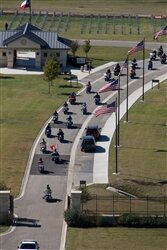
Nearly 1,200 riders depart the Central Texas State Veterans Cemetery following a Nov. 7, 2008, memorial service. The riders participated in a 60-mile safety and mentorship ride. U.S. Army photo by Chris Varville
One disturbing trend that has military leaders concerned, is the number of deaths of Soldiers while riding motorcycles, after returning from deployments in Afghanistan and Iraq. It’s something that isn’t isolated to one branch of the military or even to one particular area of the country. Motorcycle related deaths involving service members have soared and it’s a trend that has led many military leaders to take steps to ensure the safety of their Troops. It’s been surmised that Troops returning from the combat zone often crave the ‘adrenalin rush’ that they felt almost constantly while deployed, so they seek out activities that can provide a similar type of rush. One of those things are riding sport bikes, which are able to reach extremely high rates of speed in a very short time. Unfortunately, not all of our Troops who ride these motorcycles, do so safely and sadly the number of deaths has reached an alarming rate.
On the morning of November 7th at Hood Stadium on Fort Hood, the sound of almost 1,200 motorcycle engines split the air, as Soldier and civilian motorcycle riders participated in the first annual “Phantom Thunder” motorcycle safety, family time and fun ride. The ride also allowed the participants to honor the men and women who’ve served in this country’s Armed Forces and pay tribute to those who gave their lives defending this country. The rally was organized by the commander of III Corps and Fort Hood, Lt. General Rick Lynch. As he addressed the crowd, Lynch told them that he asks himself the same two questions every day. Those questions are: ‘Are we doing the right thing? and ‘Are we doing things right?’1
“What we’re doing today is, indeed the right thing,” Lynch said, noting that he implemented new rules for motorcycle riders on and off post, “because it is ridiculous to have survived the fields of battle and combat and come home and die on the highways and byways of Central Texas. I refuse to allow that to happen,” he said.2
Because Veterans Day was quickly approaching, Lynch used the motorcycle ride to accomplish another mission. To pay tribute those who have served in this country’s Armed Forces, today and in past battles. Lynch recognized World War II Veterans and singled out an 83 year old veteran who planned to participate in the ride.
“Thank you for your courage,” he said. “We complain about our 12 to 15 month deployments, but yours lasted five years. You and your generation mounted up and went to war and didn’t come back until the war was over. Just know we love you and appreciate you.”3
Besides Soldiers, other groups and organizations participated in the event. Two of those groups, the Patriot Guard Riders and the Combat Veterans Association were recognized by Lt. Gen. Lynch, for the things they do for our Troops and for our Fallen Warriors. Many of our readers are active in Patriot Guard Riders, working hard to ensure that the families of our fallen aren’t harrassed by protestors.
“You amazing people … have been at memorial services and funerals for our fallen comrades for the past six years, … and are there to assure that there is no disturbance to the dignity and solemnity of the event,” he said. “Thank You.”4
The Phantom Thunder event was an huge success at Fort Hood, as riders participated in a ride from Fort Hood to the Central Texas State Veterans Cemetery located south of Killeen, Texas. The weather couldn’t have been more perfect with temperatures close to 70 and the skies clear. Upon arriving at the cemetery, Lt. General Lynch and Command Sgt. Major Neil Ciotola, presented a wreath in honor of all veterans and then saluted the traditional Army memorial with an M-16 firle and helmet on a pedestal.5 I hope that more installations will follow the lead of Fort Hood in holding such events to promote the safety of their Troops, who ride motorcycles.
- http://www.defenselink.mil/news/newsarticle.aspx?id=51870 [↩]
- http://www.defenselink.mil/news/newsarticle.aspx?id=51870 [↩]
- http://www.defenselink.mil/news/newsarticle.aspx?id=51870 [↩]
- http://www.defenselink.mil/news/newsarticle.aspx?id=51870 [↩]
- http://www.defenselink.mil/news/newsarticle.aspx?id=51870 [↩]
Virtual Veterans Day Parade
November 11, 2008
A couple of months back, CJ at contacted MilBloggers, asking us to take part in a Virgual Veterans Day Parade. Quite a few MilBloggers responded and CJ has created a video of the responses. Enjoy the parade and don’t forget to THANKrent a car bulgaria a Veteran!
Next Page »


 Subscribe
Subscribe
